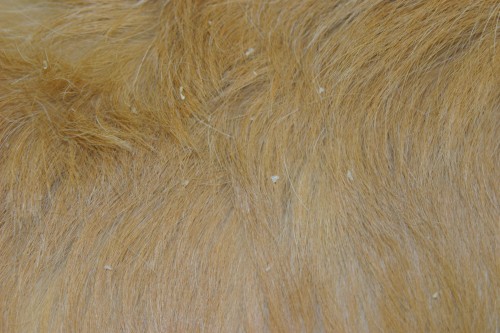What to do and why does my dog have dandruff?
Does your dog have dandruff and you don’t know what to do? This skin problem may require a gentle and natural treatment or a medical treatment if the issue persists chronically.
My dog has dandruff: what causes it?
Your dog may be prone to dandruff (called flakes in animals) due to various causes:
An excess of grooming. A mild shampoo can become aggressive for their skin if it doesn’t have time to regenerate its sebum. A brush unsuitable for their coat (for example, a pin brush on a short-haired coat) can also cause skin irritation, drying it out and causing dandruff.
But the opposite can also be true. Neglected grooming of your pet can lead to poor skin ventilation, resulting in excess matter.
Parasites present in their fur (ticks, fleas, lice,…).
A dry climate, leading to regular skin scratching and irritation.
A bacteria that creates an infection (which is common in dogs).
A dietary deficiency in omega-3 fatty acids, vitamins, trace elements. If your dog is losing hair, it’s very important to ensure they have a diet rich enough in these nutritional elements. Indeed, without them, the skin is drier, hence the dandruff.
Any dermatosis causing hair loss in dogs and cats can also lead to dandruff in both dogs and cats. When the hair falls out, small flakes are often associated. Allergies or various parasites can be responsible for itching and therefore hair loss.
Finally, a general condition that can affect the animal’s health may also lead to dandruff in the coat. This is not the only clinical sign in most cases.
If my dog has dandruff, how do I treat it?
An appropriate diet and lifestyle can solve this problem of dry skin and relieve your dog, who may scratch and damage their skin.
Start with regular grooming and using mild shampoos suitable for their skin. Don’t wash your dog too frequently, they don’t need it! Once a month is sufficient, even if they have long hair. Sometimes, visit an experienced groomer who uses natural products. Clean and moisturise their skin with natural oils and lotions available in spray or cream form. Consider buying an anti-dandruff (anti-seborrhoeic) shampoo which will be gentler than a regular shampoo.
Use non-toxic or harsh products when cleaning your home. Black soap and fragrance-free products are recommended.
If this isn’t enough, you may sometimes switch to a diet with hypoallergenic kibbles containing food hydrolysates. Dietary supplements can also provide relief (Essential fatty acids…), add them to their bowl. Your dog needs ‘good’ lipids in their diet, especially those found in certain fish. They are partly responsible for the quality of the sebum on their skin.
Finally, it’s urgent to treat your dog for parasites, particularly fleas, present all year round.
And if symptoms persist or worsen, it is important to consult your vet.
Legal mentions DermaVet
Mots Recherchés
Dog dry skin, dog skin problem, skin crust dog, crust on dog skin, problems, veterinary medicine, pet article, dog dull coat dandruff, dog blackhead skin, remove cat dandruff, skin flake, cat coat dandruff, odour, fall, well-being, state, form, dog skin disease crust, dog hole in skin, dog skin crusts, abscess, wounds, crusts, dog itching without fleas, dog skin disease crust, white spot dog skin, itching, dog hind itching, dog hair loss hind, dog tail crust, puppy crust 2 months, hind, itching, treatments, remedies, stressed dog dandruff, dog red skin hair loss, dog sebum, animal flake, brown spot dog hair, atopic dermatitis, diseases, undercoat, patches, losses, dead dog tail, head crust dog, white mite dog, my dog has yellow discharge, dead skin back, syndrome, water, diagnosis, swimming, companion, clinical examination, appointment, yellow crust dog, cat white dandruff, dog shedding skin, my bitch has white discharge, my bitch has yellow discharge, pieces, particles, feline, renewal
